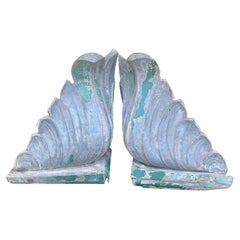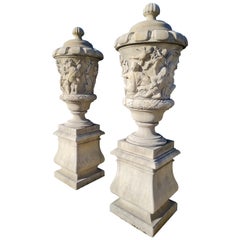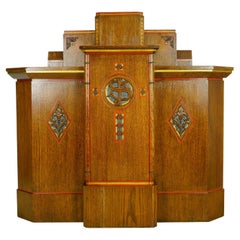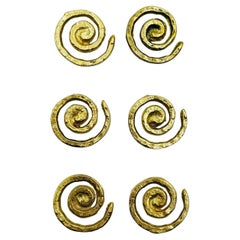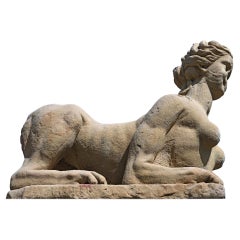Architectural Elements
to
571
1,972
1,564
3,222
388
47
Height
to
Width
to
238
181
135
132
120
109
109
99
93
82
80
63
53
41
37
13
11
5
715
1,278
1,229
435
403
413
226
48
10
86
64
32
70
80
79
14
20
1,258
1,210
923
597
452
2,429
885
554
537
495
3,657
3,412
3,533
60
35
24
20
15
Architectural Elements For Sale
Pair of Hand Formed Sheet Metal Architectural Finials
Located in Hanover, MA
Pair of hand cut and formed sheet metal corner architectural finals possible for a ridgecrest.
Looks and feels like copper although I believe it is something else, like zinc or magn...
Category
Late 19th Century American Victorian Antique Architectural Elements
Materials
Sheet Metal
Fine Pair of Italian Carved Stone Garden Vases with Base
Located in Rome, IT
Elegant stone vases on base, decorated with finely carved mythological scenes.
Timeless decoration for you garden or interior.
Category
20th Century Italian Neoclassical Architectural Elements
Materials
Stone
Large Safavid 17th C. Cuerda Seca Pottery Tile from Isfahan Floral Arabesques
Located in Bad Säckingen, DE
A vibrant Safavid cuerda seca pottery tile from Isfahan, Iran, dating to the 17th century. This finely crafted example showcases the hallmark characteristics of Safavid artistry, fea...
Category
17th Century Persian Islamic Antique Architectural Elements
Materials
Ceramic, Pottery
1940s Art Deco Restored Oak Church Lectern Podium
Located in New York, NY
1940s newly restored dark tone oak lectern with an emblematic S carving in the front center and vibrant red and yellow Art Deco painted accents. Good condition with appropriate wear ...
Category
1940s American Art Deco Vintage Architectural Elements
Materials
Oak
Set of 6 Solid Brass Cabinet Pulls, Mexico 1950's
Located in Los Angeles, CA
Add a touch of vintage charm to your cabinets with this set of 6 Solid Brass Cabinet Pulls from Mexico, dating back to the 1950s. Each pull features a unique spiral design, crafted f...
Category
1950s Mexican Mid-Century Modern Vintage Architectural Elements
Materials
Brass
Early 18th Century Sphinx Florence around 1700 Sandstone Garden and Park Object
Located in Epfach, DE
Sphinx from Florence of the Early 18th Century: A Symbol of Grace and Power
The Sphinx, crafted around 1700 in Florence from sandstone, is a captivating example of garden and park a...
Category
Early 17th Century Italian Egyptian Antique Architectural Elements
Materials
Sandstone
French Style Wrought Iron Greenhouse with Door and Windows in White Color
Located in Marbella, ES
French style wrought iron greenhouse with doors and windows that open outwards in white color. Ready for glass panels to be installed.
Category
2010s French Architectural Elements
Materials
Iron
Late 19TH Century Cast Iron Lamp Post Base heavy decorative floral relief
Located in Buffalo, NY
Late 19TH Century Cast Iron Lamp Post Base heavy decorative floral relief ..Wonderful design,, 4-sided, (MATCHING) one panel removable (access pane...
Category
1890s American Gothic Revival Antique Architectural Elements
Materials
Iron
Louis XVI Style Carved Giltwood Panel or Overdoor Fragment
Located in Nashville, TN
Rope turned pattern with water and matte gilding .Nicks , chips and minor losses and subsequent touchups. Red bole bleeding through gilding in places.
Category
19th Century French Louis XVI Antique Architectural Elements
Materials
Wood
Hand Forged Iron Moorish Folding Screen
Located in Moreno Valley, CA
Hand forged folding Moroccan iron screen with three panels decorated with Moorish designs.
Classic and elegant Art & Craft this highly embellished, detailed folding screen divider in the Mediterranean Spanish style iron art work would embellish any room, garden or wall, Santa Barbara style.
Could make an amazing headboard.
Three panels folding iron screen with Moorish designs in repeat.
Heavy and well-made original condition.
Each panel: 68.5" high, 15.75" wide
Folds up for easy storage.
Hand forged heavy wrought iron screen divider by skilled Moroccan artisans in Marrakech Morocco.
Rustic Spanish colonial style wrought iron window grill...
Category
20th Century Moroccan Moorish Architectural Elements
Materials
Wrought Iron
Antique Relief Tile Panel in the Style of J. Parentani, 1890
Located in Rijssen, NL
Stunning Art Nouveau/ Arts & Crafts tile panel from the superb firm, Craven Dunnill, & Co., Ltd, Jackfield Salop, England, circa 1905, in a bright celadon. This quantity original jug...
Category
1890s French Medieval Antique Architectural Elements
Materials
Earthenware, Pottery
Collection of 23 Italian Hand-Painted Glazed Terracotta Tiles — From Iris Apfel
By Deruta
Located in Morristown, NJ
Colorful collection of twenty-three Italian hand-painted glazed terracotta tiles, mid-20th century, in various floral and geometric patterns. Likely produced in Deruta or Vietri sul ...
Category
Mid-20th Century Italian Mid-Century Modern Architectural Elements
Materials
Ceramic
Early 20th Century English Bronze Ship’s Bell
Located in Worcester, GB
Early 20th Century English Bronze Ship’s Bell
A finely cast English ship’s bell dating to the early 20th century, circa 1910–1930. Executed in solid bronze w...
Category
Early 20th Century British Architectural Elements
Materials
Bronze
Entrance or Passage Way Large Starburst Door Hardware Kit
Located in South Charleston, WV
Produced for clients not wishing to purchase out doors directly and to provide their own extant or newly purchased door for a modern look For use on exterior or interior doors. For ...
Category
2010s American Mid-Century Modern Architectural Elements
Materials
Brass, Stainless Steel
Vintage wood room divider - 1960s
Located in Linkebeek, BE
Vintage wood room divider - 1960s
Wear consistent with age and use.
Room divider - Séparateur de pièce
Measures : 61,5x19,5cm H:217cm
Category
1960s Mid-Century Modern Vintage Architectural Elements
Materials
Wood
Pair Italian 18/19th Century Hand Carved Giltwood Floral Ornaments
Located in Buisson, FR
Beautiful handcarved giltwood floral ornaments that once adorned a chapel .Original period pieces that due their high age have a wonderful weathered look.
Italy circa 1780/1850 , wea...
Category
18th Century Italian Antique Architectural Elements
Materials
Wood
$810 Sale Price / set
50% Off
19th Century Victorian Carrara Marble Mantel Keystone
Located in Stamford, CT
A 19th Century Victorian carrara marble mantel keystone with a carved scallop shell. This is a beautiful antique carved marble fireplace mantel keystone, featuring a scallop shell design. These keystones were often the decorative centerpiece of Victorian-era fireplaces and reflect the intricate craftsmanship of the 19th century. This is one of the best carved marble keystones...
Category
Late 19th Century American Antique Architectural Elements
Materials
Carrara Marble
Pair of 18th Century Architectural Panels with Swags Hand Carved in Low-Relief
Located in Atlanta, GA
A pair of French hand carved wooden decorative panels from the 18th century, with ribbon-tied swags, flowers and fruits. Born in France during the Age of Enlightenment, each of this ...
Category
18th Century French Antique Architectural Elements
Materials
Wood
1930s Corrugated Fire Resistant Clear Chicken Wire Glass
Located in New York, NY
Priced per square foot.
Reclaimed from old warehouses and industrial buildings, this corrugated industrial glass was used as exterior awnings or part...
Category
1930s American Industrial Vintage Architectural Elements
Materials
Glass
Set Chinese Carved Panels Screen Room Divider 1880
Located in Potters Bar, GB
Gorgeous set of four hand carved Chinese screens
These were originally part of a screen or room divider and could be put back together to serve that purpose if required
Good size at ...
Category
1880s Chinese Export Antique Architectural Elements
Materials
Wood
Radiator cover in bamboo and Vienna straw with leather bindings. Molto Editions
Located in Roma, RM
Radiator cover in bamboo and Vienna straw with leather bindings. Molto Editions
Italian artisanal production
Dimensions: 92L x 100H x 20D cm
Other size available please contact us if...
Category
2010s Italian Architectural Elements
Materials
Leather, Bamboo
16th Century oak carved Gothic Panel, Belgium
Located in Meulebeke, BE
16th century / Belgium / Letter Panel / Oak / Gothic
A finely carved Gothic oak panel from 16th-century France. This architectural fragment features graceful vertical fluting framed...
Category
16th Century Belgian Gothic Antique Architectural Elements
Materials
Oak
19th C. French Architectural Panel with Decorative Carving and Gold Paint
Located in Kent, CT
19th C French architectural panel featuring intricate carving of fruit swags, a crowned face, and gold-painted highlights. This panel was m...
Category
19th Century French Antique Architectural Elements
Materials
Wood, Giltwood
Antique Mantel
Located in Made, NL
Antique Paonazzo Marble Chimneypiece for Sale
There is something undeniably captivating about an original antique fireplace mantel, especially one crafted from a rare and beautif...
Category
19th Century French Louis XIV Antique Architectural Elements
Materials
Marble
$21,018
Antique Marble Fireplace with Cast Iron Stove
Located in Haarlem, Noord-Holland
Amazingly colorful French Louis XV fireplace mantel from Paris, France.
This bright and friendly pompadour style mantel comes with cast iron stove and...
Category
19th Century French Louis XV Antique Architectural Elements
Materials
Marble, Breccia Marble
Baradari in White Marble Handcrafted in India
Located in New York, NY
Baradari, also Bara Dari, is a building or pavilion with twelve doors designed to allow free flow of air. The structure has three doorways on every side of the square-shaped structure.
Because of their outstanding acoustic features, these buildings were particularly well-suited for mujra dance or courtesan dance performances by the noble courtesans. They were also well-suited for live performances and private concerts by various musicians and poets in front of the ruling kings of the time. They were also valued for their fresh air during hot summers of India. Bara in Urdu/Hindi means Twelve and the word Dar means 'door'.
Baradari in white marble
Size= 144" x 144" x 120" H
Material= White Agra marble...
Category
2010s Indian Agra Architectural Elements
Materials
Marble
$72,000 / item
Alvar Aalto Sculptural Aluminium Door Handles
By Alvar Aalto
Located in Turku, Finland
Sculptural Door Handles designed by Alvar Aaltos. Made in Finland.
Material: Alumininum
Includes two handles and spacer. No connecting screws / rose screws.
Category
1980s Finnish Mid-Century Modern Vintage Architectural Elements
Materials
Metal, Aluminum
$1,050 Sale Price
30% Off
Mid 20th Century Stained Glass Windows Fruit & Leaves, Jewels
Located in Port Jervis, NY
Fabulous set of 4 leaded and stained glass windows. Excellent craftsmanship and design in the framework of these 4 windows. Red cherrie...
Category
1950s American Art Nouveau Vintage Architectural Elements
Materials
Lead
Early 20th C. Neoclassic Style Zinc Arched Pediment w/Great Patina, 4 ft
Located in Atlanta, GA
An American zinc arched pediment from the early 20th century. This antique architectural piece from American has been designed with Neoclassical inspired wreath and ribbon bow-ties within its center and has a half-moon, arched shape with flattened bottom edge. This piece is nicely aged, with zinc atop wood which has a beautiful rusty patina throughout. There is a newer wood replaced at backside. This early 20th century architectural zinc pediment...
Category
Early 20th Century American Neoclassical Architectural Elements
Materials
Zinc
Grand 17th C. Viennese Baroque Archway Wood Door Surround Architectural Element
Located in West Hollywood, CA
Grand 17th C. Viennese Baroque Archway Wood Door Surround Architectural Element . Outstanding workmanship of the Masters of the Craft. Large Carved wood black, tone down red and Gilt...
Category
Late 17th Century European Baroque Antique Architectural Elements
Materials
Wood, Giltwood
$120,000 Sale Price
25% Off
Beautiful Breche Marble Fireplace Mantel, Free Shipping
Located in Haarlem, Noord-Holland
Its a pleasure to offer this wonderful French fireplace in beautiful Italian Breche (Breccia) marble.
This early 19th century transitional (XIV - XV) mantel shows a great variety of ...
Category
19th Century French Louis XV Antique Architectural Elements
Materials
Breccia Marble
Pair of 17th/ 18th Century Italian White Marble Baroque Ornaments
Located in Buisson, FR
Unique and very beautiful pair weathered white marble baroque ornaments. They most likely once adorned a church altar.
Original period pieces, Italy, circa 1650-1750. Weathered and s...
Category
17th Century Italian Baroque Antique Architectural Elements
Materials
Marble
$1,074 Sale Price / set
52% Off
Elegant Wall Barometer in Brass & Glass by Taylor
By D. Taylor
Located in San Diego, CA
The beautiful design on this wall barometer by Taylor in patinated brass and glass can be hung on the wall or table top.
Category
20th Century American Mid-Century Modern Architectural Elements
Materials
Brass
$220 Sale Price
20% Off
FOUR Individual Ceramic Delft Wall Tiles Hand Painted, 19th Century
Located in Lincoln, Lincolnshire
These are four attractive individual Delft ceramic wall tiles, dating to the second half of the 19th century.
All tiles are nominally 5 inches square and 5/16 to 3/8 inches thick....
Category
19th Century Dutch Dutch Colonial Antique Architectural Elements
Materials
Ceramic
Pair of 19th C. Italian Carvings on Wood Bases
Located in Los Angeles, CA
19th C. Italian pair of ornate, antique architectural elements featuring intricate acanthus leaf designs. They are mounted on rectangular wooden bases, which show signs of age with ...
Category
19th Century Italian Rococo Antique Architectural Elements
Materials
Wood
$360 Sale Price / set
20% Off
Wood Sculpture Container from Old Water Mill Gear, China 1800-40
Located in Round Top, TX
This wood accent piece originally served as a section of gear work from a water mill in China. The deep worn patina of the rich hard wood is warm and inviting. May be used as a conta...
Category
Early 19th Century Chinese Chinese Export Antique Architectural Elements
Materials
Wood
Large Belgian Neo-Gothic Painted and Giltwood Architectural Element
Located in San Francisco, CA
Of Neo-gothic style and large scale with a protruding cornice carved with a meandering foliate vine; above an openwork body with trefoil and quatrefoil pierced reserves over a pointe...
Category
1860s Belgian Gothic Revival Antique Architectural Elements
Materials
Wood
Sensational Timeless Chateau Fireplace Surround
Located in Beervelde, BE
Sensational French antique fireplace surround for the connoisseur.
Late 16th - early 17th century period chateau fireplace surround in great authent...
Category
16th Century French Louis XIII Antique Architectural Elements
Materials
Limestone
Richard "Dick" Harvey Sculpta Grille Room Divider by Modernica
By Don Harvey
Located in Dallas, TX
This is a free standing "Contemporary" model C-20 Sculpta room divider.
Born in 1919 and raised in New York City, Richard "Dick" Harvey studied art at Brooklyn Tech High school an...
Category
Mid-20th Century North American Mid-Century Modern Architectural Elements
Materials
Resin, Wood
Arne Jacobsen Brass Door Handle Sets in Solid Brass
Located in Copenhagen, DK
Arne Jacobsen - Scandinavian Modern
Original, solid brass door handles. Beautiful organic shape. An iconic design for both modern and classic interiors.
Designed for the SAS H...
Category
Mid-20th Century Danish Mid-Century Modern Architectural Elements
Materials
Brass
Seguso Vetri d`Arte Bitta Door Handle Murano Glass
Located in Murano-Venice, IT
Bitta Murano glass door handle by Seguso Vetri d'Arte. Handmade, blown Murano glass in an elegant, modern shape. The round door handle has a g...
Category
21st Century and Contemporary Italian Architectural Elements
Materials
Murano Glass
$2,750 / item
Large Lateral Push Pull Door Handle of Cast Bronze
Located in London, GB
A large lateral push-pull door handle of abstract Brutalist design. European, second half 20th century.
A striking piece - made to span the full width of a door - formed from cast ...
Category
20th Century German Mid-Century Modern Architectural Elements
Materials
Bronze
Italian Decorative Wall Panel Carved w/Helmet, Horn & Arrows, 19th Century
Located in Atlanta, GA
An Italian hand-carved wall plaque, with its original painted and gilt finish, from the 19th century. This antique wall decoration from Italy features a rectangular-shaped molded surround, with quarter-circle inner edges, that frame a carved assemblage of helmet, horn, arrows, and foliate motif at center with carved-rope and bow-tied ribbon in gilt. The original hand-painted finish has a faux marble background in gray hues, with green, red and gilt accents on the center carvings. This 19th century Italy carved plaque...
Category
19th Century Italian Antique Architectural Elements
Materials
Wood
Antique European Encaustic Cement Tiles. Pre-WWII
Located in Baltimore, MD
Encaustic cement tiles were pioneered by the French in the middle of the 19th century and relied on chemical curing rather than traditional firing. This technique had the advantage ...
Category
1930s European Vintage Architectural Elements
Materials
Cement
Tall Pair of Pine and Brass Obelisks, 1970's
Located in Bainbridge, NY
Pair of Knotty Pine Obelisks, Circa 1960's. Featuring three solid panels of smooth, adhesed Knotty Pine with thin tipped pyramidal apex, atop 1.25H balanced square Brass box, bases ...
Category
1970s American Mid-Century Modern Vintage Architectural Elements
Materials
Brass
19th Century Neoclassical Style Glazed Terracotta Architectural Element
Located in Stamford, CT
19th century terracotta architectural element with white glaze. The panel is decorated with bell flowers on either side. This piece has a wonderful craquelure surface, with crazing t...
Category
Late 19th Century American Neoclassical Antique Architectural Elements
Materials
Terracotta
16th Century oak carved Gothic Panel, Belgium
Located in Meulebeke, BE
16th century / Belgium / Letter Panel / Oak / Gothic
A finely carved Gothic oak panel from 16th-century France. This architectural fragment features graceful vertical fluting framed...
Category
16th Century Belgian Gothic Antique Architectural Elements
Materials
Oak
Small Marble Louis XVI Fireplace Mantel
Located in Haarlem, Noord-Holland
Small and elegant white marble Louis XVI fireplace mantel.
Lovely original conditions with some dicoloring in the topsheld.
Would be perfect for a...
Category
19th Century French Louis XVI Antique Architectural Elements
Materials
Carrara Marble
Large Late 17th Century Baroque Iron Door Lock
Located in Haddonfield, NJ
Large French baroque wrought iron door lock on acrylic stand.
Category
Late 17th Century French Baroque Antique Architectural Elements
Materials
Wrought Iron
$650 Sale Price
48% Off
1930s Bauhaus Era Solid Brass Water Tap's - Faucet ´s
Located in Esbjerg, DK
A set of 2 solid brass water faucets. Both tested and in working order and both come with original hose connectors. Made in Europe, probably Scandinavian/Sweden during the 1930s. You...
Category
Early 20th Century European Bauhaus Architectural Elements
Materials
Brass
Concrete Demilune Sculptural Cherub Angel Garden Plaque Pediment
Located in Dayton, OH
20th century demilune shaped sculptural wall pediment. Features figural cherubs or angels holding onto a wreath. Very heavy. Original mounting brackets o...
Category
20th Century Victorian Architectural Elements
Materials
Concrete
$960 Sale Price
20% Off
Antique fireplace of french limestone in style of Campagnarde, 19th century
By Rustic Design
Located in Made, NL
Very nice rustic mantelpiece of gray marble stone. A mantelpiece with few ornaments, but with beautiful lines and slightly curved legs. This mantelpiece in Campagnarde style is from ...
Category
19th Century French Other Antique Architectural Elements
Materials
Limestone
Antique mantel of Breche Violetta marble from the 19th century
Located in Made, NL
A One-of-a-Kind 19th Century French Marble Mantel
This antique marble mantel from 19th-century France is a fine example of the Louis XV style, celebrated for its flowing curves and ...
Category
19th Century French Louis XV Antique Architectural Elements
Materials
Marble
Antique Walter MacFarlane & Co English Cast Iron Royal Coat Of Arms Shield 61"
Located in Dayton, OH
Very heavy and large Mid 19th Century English Cast Iron Royal Coat of Arms Shield or Crest. Made from solid Cast Iron from the Walter MacFarlane & Co, Saracen Foundry Possil Park Gl...
Category
Mid-19th Century Antique Architectural Elements
Materials
Iron
19th Century Trade Sign Clothing Wood Double Sided Wooden Hudson Valley NY
Located in Newfoundland, PA
Take a look at this fantastic double sided early 19th or late 18th century wooden trade sign with original wrought Iron bracket. Came out of a Hudso...
Category
Mid-19th Century American Primitive Antique Architectural Elements
Materials
Iron
Large Hand Forged Wrought Iron Candle Chandelier for Dining Room, Restaurant Etc
Located in Lisse, NL
Museum quality, forged in fire, Medieval castle-design chandelier.
This excellent quality AND condition pendant is all hand-forged and its design and perfect execution lifts it abov...
Category
Late 19th Century Dutch Arts and Crafts Antique Architectural Elements
Materials
Wrought Iron
Gaudi Ceramic Tile Hand Painted Colors
By Theia Tiles
Located in Lisbon, PT
Laced blankets, crochet throws and knitted mantles are at the heart of Gaudí. Handmade is the focal point to the Gaudí tile, where soft lines create a we...
Category
2010s European Modern Architectural Elements
Materials
Ceramic
$505 / item
Impressive Architectural Gilded Decorative Door Panel, Italy, Early 18th Century
Located in London, GB
Northern Italy, early 18th century
With feature generously proportioned gilded scrolls surmounted with an acanthus leaf crest motif. Would be stunning if re-appropriated as a full height mirror...
Category
Early 18th Century Italian Antique Architectural Elements
Materials
Gold Leaf
18th Century Spanish Baroque Carved Giltwood Altar Ornament with Angel Head
Located in Buisson, FR
Wonderful baroque altar ornament with Angel head. Great and unique item.
Spain circa 1750
Weathered, losses and old repairs.
More photo's available on request.
Measurements include ...
Category
18th Century Spanish Baroque Antique Architectural Elements
Materials
Wood
$4,534 Sale Price
30% Off
18th Century Hand Carved Stone Coat of Arm Wall Mount Art Overdoor Crest Antique
Located in West Hollywood, CA
18th Century Hand Carved Stone Coat of Arm Wall Mount Art Overdoor Crest Antique . Rare 18th century Blason Armorial Armoirie Coat of Arms with finely hand carved scrolls around an oval medallion. Great to wall mount this historic sculpture...
Category
18th Century French Antique Architectural Elements
Materials
Stone, Limestone
$6,960 Sale Price
20% Off
Still Thinking About These?
All Recently ViewedMore Ways To Browse
Iron Balcony Railing
Iron Corbels
Iron Greenhouse
Lightning Rod
Monastery Doors
Romanesque Capital
Used Stair Railings
15th Century Architectural Fragment
15th Century Coffer
Antique Lightning Rod
Antique Plaster Corbels
Art Deco Grill
Chinese Green Tiles
Copper Corbels
Figural Corbels
French Devres Tile
French Wrought Iron Railing
Gothic Salvage
